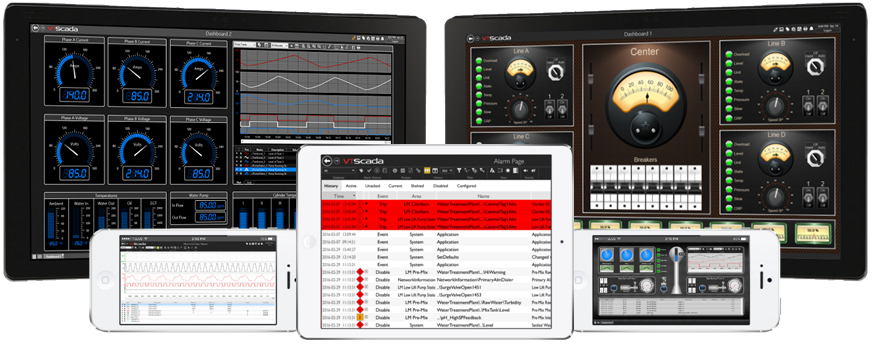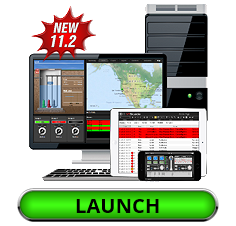A Telemetry Expert Describes How and Why Temporary Mobile I/O Will Transform Remote Asset Management
Over the last decade, remote access to SCADA applications has changed drastically driven by evolving technology and end user requirements. What was once a helpful way to check levels and respond to alarms from home has grown exponentially with the ubiquity of smartphones and tablets. Jeff Harmon has worked in the municipal water and sewer field for over 30 years. He is now the Assistant Director at an award winning water and wastewater utility in Tennessee. He sees how advances in SCADA software, telemetry hardware, and secure private networks have the potential to create another sea change in mobile monitoring. He envisions maintenance workers in the field tracking down issues with the help of portable cellular telemetry devices. Workers can instantly begin troubleshooting equipment or isolating points of water loss using live data on their smartphones. In this article Harmon describes what is motivating this kind of innovation as well as the challenges faced by those seeking to adopt it.
A Long History of SCADA
Jeff Harmon has had a long relationship with Supervisory Control and Data Acquisition (SCADA) systems. First as a systems integrator who has developed and maintained numerous applications for municipal utilities and now as the Assistant Director at a utility responsible for processing billions of gallons of water and wastewater a year. “My early life in water and sewer was developing data collection systems and developing water and sewer hydraulic models,” says Harmon. “I have been at this from the very first SCADA systems that came out up until now. It’s interesting to see what’s going on in the industry and where the new battle lines are. What’s changed the game is the need to have a lot more field data that is temporary.” Several different technologies make temporary mobile I/O possible:
BYOD – Bring Your Own Device
The affordability of wireless tablets has made it feasible for operators and maintenance crews to use them in the field for a variety of activities. Many utilities have even started adopting the strategy of bring your own device (BYOD) to take advantage of the smartphones that workers already carry in their pockets.
Next Generation SCADA Software
Modern SCADA software platforms like VTScada from Trihedral have made it simple for authorized users to manage alarms and perform full monitoring and control from anywhere. Users can choose the display format that makes the best use of their screen size. Trends can be opened and manipulated with a touch and a pinch. Integrated mapping allows users to navigate remote monitoring sites the same way they use online map sites.
A New Generation of Telemetry Hardware
“Now you have new breeds of data acquisition equipment coming along,” explains Harmon. “What they offer is the ability to go out and stick a pressure monitor on an asset. It screws in and it starts measuring pressure. It already has a cell modem built into it. You can host the data in their cloud, or you have the option of hosting it on your own network. The nice thing about it is that it registers its location through GPS and not by what the signal is. So you can put one of these things on a hydrant and gather data. Then you can move it to a different location and record that data. The database sees the difference even though it’s the same transmitter gathering from a different point.”
Bringing it All Together
What Harmon envisions is this. If, for example, your SCADA system identified a water flow issue, workers would go to that area and quickly install a portable pressure gauge on one of the nearby fire hydrants. (This could also be accomplished with a flow meter in a sewer scenario.) The utility’s SCADA system at the head office would immediately begin poling the gauge via the cellular modem and logging the data into the historical database. The workers would then retrieve and trend the readings using thin clients running on their portable phones. “They can instantly locate themselves on a system map and begin trending data alongside fixed data signals from, for example, an elevated tank. There is no need to hire an integrator to configure that data point and create a plot. Those tools are now in their hands.”
Workers could move from hydrant to hydrant until the issue was identified. If maintenance is required, the workers can consult real-time data to determine the effectiveness of their work. “Once the problem is fixed they can pack it all up and head back to the office or move on to the next problem,” says Harmon.
“This allows your people to turn right around and start figuring out where the problem is. This is a big change from gathering data in plants where nothing moves around. This PLC gathered this particular kind of data. You could always associate a tag name with a particular signal.”
The Challenges to This Approach
Didn’t we already pay for a SCADA system? – “What’s interesting is that you have these SCADA software players in the industry that are more traditional and don’t really lend themselves to deploying on cell phones and gathering temporary data from field assets. One of the biggest challenges is that if you have a utility that has already invested money in one of these SCADA systems, what do they do now? They are struggling with questions like ‘How do I pay for this?’ and ‘Don’t I already have a SCADA system that does this?’”
There are several ways in which this cost can be mitigated. One is reduced integration costs and increased response times. Ordinarily, it can be expensive for the utility’s systems integrator to install each new data point and configure them within the SCADA application. The installation process could take weeks. This is impractical in maintenance scenarios where delays compound problems. It is also wasteful, since the new data points will no longer be necessary once the issue is resolved.
Harmon describes another way to justify this cost, “What is driving all of this is water loss on the water distribution side and inflow and infiltration reduction in sewer collection systems. Some utilities have it worse than others. They have to account for these problems now in terms of dollars lost to unnecessary treatment.” Temporary Mobile I/O provides a flexible and responsive strategy for locating leaks in the water system or finding inflow locations in a sewer system. “If you didn’t have to produce as much water, what does that represent to you in terms of savings?”
“Putting the power of real time data in the hands of your field personnel is thus becoming a necessity. And ultimately, all this data feeds into the bigger picture of work order analytics and asset management programs. This allows managers to make better decisions because they can see the value of replacing a water line. This factors into their long term buried asset replacement program.”
Is it secure? – “A lot of people managing municipal systems worry that a mobile phone or tablet is not secure,” says Harmon. “But it is secure. We have our own mobile private network through Verizon. Those are becoming much more common. Utilities are getting smart and putting their devices on these private networks. Just because someone has a Verizon phone doesn’t mean they are on the same network as us. My tablet can be totally isolated from everybody else. That’s changed the game a bit and it’s starting to allay people’s fears.”
Can we train our team to actually do this? – “I’ve got people who aren’t used to dealing with computers but they are getting used to dealing with cell phones. If they see that there is a value in this, they will learn it. But if it’s hard to configure and it’s hard to work then they are not going to use it. That’s the one thing we have seen is that they will adopt the technology if it makes their lives easier.”


